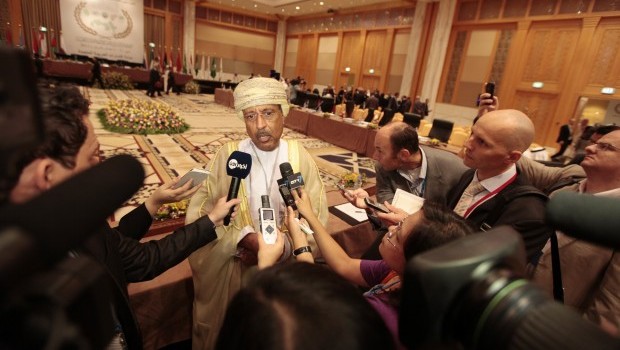
Oman’s minister of financial affairs, Darwish Ali Al-Balushi, speaks to members of the media during the first day of the Arab Finance Ministers summit meeting in Dubai on April 2, 2013. (REUTERS/Jumana El Heloueh)
“This year we do not plan but maybe for next year, and this is not because of our immediate borrowing requirements but because we want to pave the way for the private sector,” Balushi said late on Saturday.
“We want to establish a benchmark,” he said on the sidelines of a meeting of Gulf Arab finance ministers in Bahrain.
Oman last tapped the international bond market with a USD 225 million eurobond in March 1997, when oil prices stood at around USD 20 per barrel. It sold a five-year bond at a premium of just 73 basis points over US Treasuries.
Since then, oil prices have risen sharply, to above USD 100 at present, so the country—which currently depends on oil for 86% of its budget income—has not needed to issue much debt. With the exception of 2009, it has posted budget surpluses every year since 1998.
In recent years it has sold small issues of local currency development bonds, but the ratio of its gross government debt to gross domestic product was just 6.1% in 2012, the second lowest in the Gulf after Saudi Arabia, compared to a peak of 38.6% in 1998.
Balushi said his ministry had not yet decided on the parameters of the new dollar bond but it would be at least of benchmark size; typically, that means USD 500 million.
“We will see. It should be something reasonable to attract investors because if it is too small, investors will not be [interested]—we want to also attract a variety of investment.”
SINCE THE UPRISINGS elsewhere in the Arab world in 2011, pressure on Oman’s budget has increased as it has spent more to ensure social peace. Balushi estimated in January that the government would need an oil price averaging USD 104 to balance its budget this year.
The International Monetary Fund presented a bleak outlook for Oman’s public finances last month, predicting the budget could slip into a deficit of 3.8% of GDP as soon as 2015, with the gap widening to as much as 13.3% in 2018.
By reestablishing Oman’s presence in the international bond market, a sovereign issue could pave the way for regular deficit financing through bond issues several years from now.
Balushi said last month that spending policy would become more conservative in coming years. He insisted on Saturday that any forthcoming sovereign bond issue would not be in response to an urgent need, and he disputed the IMF’s analysis.
“This is based on a scenario that oil prices will come down from their level today and expenditure will take the same trend as in 2011, 2012 and 2013,” he said.
“We do not agree with this because we think that the trend of expenditure will not rise, because in 2011, 2012 there was some reason, but this reason will not continue and therefore expenditure will not go at the same level higher going forward.”
To diversify its economy beyond crude oil and gas production, Oman is spending heavily on industrial projects, including a multibillion-dollar scheme to transform the southern coastal town of Duqm into an industrial centre.
Creating a benchmark for Omani corporations to issue bonds could help them finance some of this construction. In March, partially state-owned Bank Muscat, Oman’s largest lender, priced a USD 500 million, five-year bond in its first dollar debt issue in nine years.
The Omani government has also said it plans its first-ever issue of rial-denominated sukuk (Islamic bonds) next year, and outlined issuance of OMR 200 million (USD 519 million) worth of local currency bonds in its 2013 budget.
